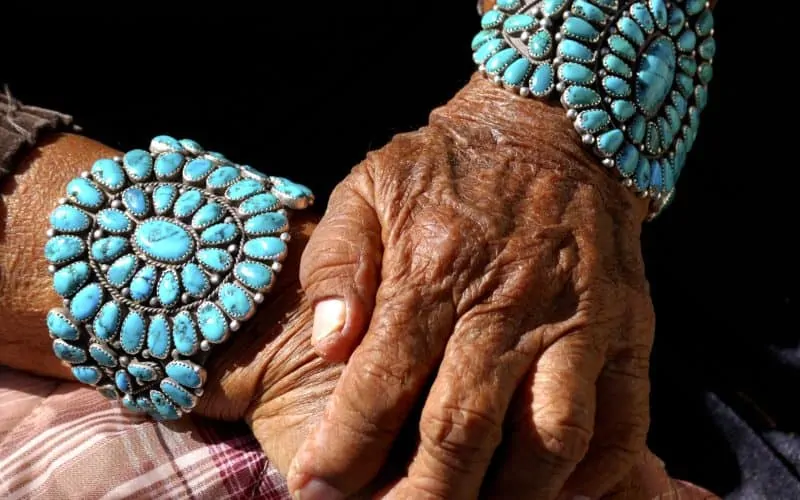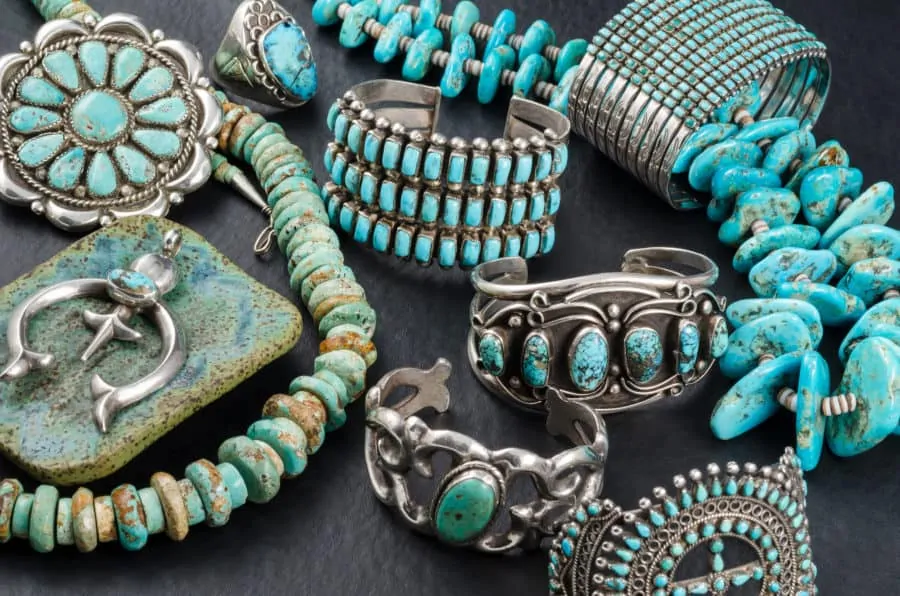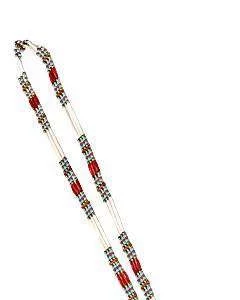Archaeologists have found evidence of the native people and what would become America creating jewelry from the stones, shells, and other natural materials as far back as 10,000 years ago. As the millennia went on, turquoise jewelry became one of the more prominent varieties made specifically by tribes in the Southwest. This was, after all, where the turquoise stone was naturally found in some quantities.
Today, people all over the world seek out authentic necklaces, bracelets, earrings, and more made by tribes that produce turquoise jewelry for sale.
Unfortunately, the world is full of large-scale jewelry manufacturers who have usurped some of the native styles and practices and now mass-produce jewelry that is “inspired” by the original artisans who handcrafted the pieces. When people do not know how to tell real turquoise jewelry from fake turquoise jewelry, or they do not care if the style was actually made by a Native American person, it can hurt both the culture and the income of tribal people.
Before diving into the question of authenticity versus mass production, it helps to understand the origins of turquoise jewelry and why it is prized so much by the people who originally used this unique stone to fashion adornments and accessories.
Origins of Native American Turquoise Jewelry
Native people in the Americas have been creating jewelry to decorate themselves and to give to others for an exceptionally long time. Some of the earliest stone tools found were drills that could create holes in natural materials like stone, antlers, shells, bone, and porcupine quills. Although many different types of stone were used, turquoise quickly became one of the most important for a handful of groups in the Southwest. The main turquoise jewelry makers were the Navajo, Hopi, and Zuni.
The Start of Silver Smithing
Prior to the mid-1800s, Native Americans primarily worked with beads and hammered and formed copper. This was a softer metal that could be fashioned into different types of jewelry with relative ease. First contacts with the Spanish who came to the south and Central America introduced the concept of silversmithing to them. This allowed them to make the styles of jewelry that many people associate with them today.
Not only did it introduce new artistic styles and methods, but the ability to work with silver combined with semiprecious stones like turquoise gave the native people the ability to trade more effectively with the newcomers. While this was certainly not an overall positive experience, the skills would carry on through the generations. When tourists began traveling westward in the early 1900s and settlers swept across the land, the turquoise and silver jewelry was established as a staple of the trade economy.
The Importance of Turquoise Stone
Needless to say, turquoise is a very attractive semi-precious gemstone that comes in a variety of blue and green colors. In fact, its appearance is so unique that an actual color was named after the stone. Turquoise is also an exceptionally hard stone that is filled with intriguing lines and shapes that give each piece a truly individual look.
Besides its lovely appearance, it is also one of the oldest stones used in jewelry, decorations, and various other types of artifacts found all over the world. The ancient Egyptians used turquoise to make special items for royalty and others. Although it was used extensively for special items, it is not exceptionally common itself. The early Native American jewelry makers prized this stone above all others. It was dubbed the “fallen sky stone” and had associations with some spiritual beliefs and the concept of Mother Earth.
Tribes That Produce Turquoise Jewelry
Although the Navajo, Hopi, and Zuni have been mentioned elsewhere in this article, they are not the only first Nations that created turquoise jewelry in history. Because of the popularity of the beautiful blue-green stone, other tribes used it as well. However, these are the largest, most well-known, and the ones who have continued the artistic tradition for the longest.
Despite their shared love of turquoise, they each had distinctive jewelry styles that people love even today. Although it is impossible to describe all of them, the following differences are noteworthy.
Navajo – This nation was the first to adopt the Europeans silversmithing methods. They used this new ability to create some of the most iconic jewelry pieces still found today. They used large chunks of turquoise in rather rough styles, especially for rings and bracelets. However, they also perfected the more delicate arts of inlay work, which is now quite popular for necklace pendants and charms. Some of the common motives include squash blossoms, flowers and plants, and beadwork.
Hopi – The artists in this tribe also used their silversmithing abilities to create unique jewelry pieces with a distinctive look and feel. They were well-known for an overlay style that created a three-dimensional silver pattern that often mimicked the look of their textiles and pottery designs. Turquoise was considered a source of protection and was used in both jewelry and home accents quite frequently.
Zuni – Both very delicate beadwork and large chunky stone fetishes are symbolic of the Zuni style. They worked with inlaid chips of turquoise and exquisitely carved beads that would be stitched together with precision and care. The sacred turquoise was occasionally used for small carved figurines or fetishes that offered protection and decoration.
Today, Native and non-natives love turquoise because it simply looks beautiful. Each piece of jewelry can have its own distinct hue and pattern that give people the one-of-a-kind looks they cherish. Its popularity has led material manufacturers to create fake turquoise from a stone called howlite, which is tied with blue and green colors.
How to Tell Real Native American Turquoise Jewelry From Fake Turquoise Jewelry
One of the easiest ways to recognize if the necklace, bracelet, or pair of earrings you are about to buy is dyed howlite rather than authentic turquoise is to check its source. Jewelry that comes directly from tribes that produce turquoise jewelry will always be real. When you are investing in jewelry that will last your lifetime and more, it makes sense to find out where it came from.
The fact that jewelry made with genuine turquoise stone is an investment is another clue that you are getting the real thing. Of course, you can find Native American-made accessories in all price points. A simple silver and turquoise pendant can cost less than $100. However, a simple silver and dyed howlite pendant will cost only a fraction of that.
Unfortunately, cost and general appearance are things that drive people to purchase imitations.
Besides price, there are two definite differences between turquoise and howlite.
First, turquoise is much harder on the Mohs scale than howlite is. Of course, if you are buying a piece of jewelry, you cannot very well attempt to scratch it or break a chip off of it.
The second clue is more obvious: general appearance.
Things to look out for if you suspect a piece of jewelry is made with howlite:
- Uniform blue-green color. Turquoise is naturally variable, and a single stone can change in hue or shade. Since howlite is dyed, the whole stone will look the same.
- Regular lines or matrices. Howlite lines or cracks are always black turquoise may have brown, yellow, or black. Also, howlite lines tend to be more uniformly spaced. They are also much shallower. Gently rub your fingernail over a piece of turquoise. If it gets stuck in the cracks, there is a greater chance that it is authentic.
- Test for dye. While you cannot carry a cotton swab and acetone or nail polish remover to every jewelry store, it may be your friend when considering an investment in an expensive piece of turquoise jewelry. A small rub will not hurt turquoise at all. Dyed howlite, however, will turn your cotton swab blue or green.
Native American Turquoise Jewelry Value Today
As mentioned above, turquoise jewelry is quite valuable in the accessories and collectibles market today. Historical pieces that are more art and artifact than fashion choices are frequently found in museums or private collections. Every day turquoise jewelry is made by top designers and bulk manufacturers alike.
As with any type of jewelry, the price tag reflects various characteristics. These include the following:
- Types of metals, stones, and other materials used
- The artistry, design, and style of the individual piece
- The reputation of the jeweler or artisan
- The authenticity and history of the jewelry
- Current interests of the market in general
Price From Materials
Genuine turquoise costs more than dyed howlite. Sterling silver costs more than base metal. When it comes to Native American jewelry, natural materials are most often used.
If you want the real thing, you will pay more for it.
Artistry and Design
Something as simple as a turquoise stone chip bead can be made in a huge factory very quickly and inexpensively. It is possible to get real turquoise without paying much. However, it is not possible to get the authentic Native American jewelry experience with these types of pieces. When you buy directly from a tribe with a master silversmith or turquoise jewelry experts, expect higher prices.
Designer or Jewelry-maker's Reputation
When an individual jewelry artist gains popularity in the marketplace, their brand is attached to individual pieces. Just like with any other so-called brand name, you will pay a premium if you want something from a specific artisan.
Authenticity and History
If you are purchasing turquoise jewelry as collector pieces and not simply fashion accessories, you must research the history of the individual necklace, brooch, or ring before taking out your wallet. Any piece with interesting provenance may bring in more money than expected.
Of course, different styles of jewelry go in and out of fashion. If you are shopping during a period when genuine turquoise is popular, you will end up paying more. This holds true for any product, style of jewelry, or consumer-focused service in the world.
Authentic Native American Turquoise Jewelry Is Protected
It is important to note that only authentic Native American jewelry can be called that by law. The 1990 Indian Arts and Crafts Act in the United States made it illegal for anyone to claim their jewelry or any other type of handcrafted item as Native American or Indian without proof that a recognized tribe actually created it. This covers everything from a turquoise ring to a woven blanket to a stone fetish to pottery and baskets and more.
Unscrupulous companies or individuals that tried to get away with this may face prison time and six-figure fines. This also pertains to any claims of association with a particular tribe. In other words, if a sign says “Navajo Jewelry” all of the pieces must have been made by a person belonging to the Navajo Nation. Under this law, only the legally recognized tribes in the United States today are covered by its protection. There are over 500 of these, and they do not all create jewelry pieces with turquoise.
In today's world, the concept of cultural appropriation has become almost a buzzword for anti-prejudicial actions and attitudes. However, stealing a people's identity in order to advertise non-authentic jewelry to the masses goes beyond this concept. You may think of it like a start-up beverage company calling itself Coca-Cola, but it goes much further and deeper than that. Coca-Cola has nothing to do with the identity of a group of people that have been systematically dismissed and downtrodden throughout history.
The protection matters for a host of reasons both cultural and economic. While modern buyers of the beautiful bracelets and pendants may not particularly care about the spiritual beliefs Navajo and Hopi artisans originally had about turquoise or how the designs they enjoy wearing were imagined hundreds of years ago, they should care about supporting the people who created the art.
Why Does This Protection Matter?
It is no mystery that the Native American population has long been affected or outright attacked when it comes to maintaining their cultural identity. The events from the early years of European colonization are well-known to anyone who was taught history in school. The forced assimilation and erasure that many tribal peoples were forced to endure have permanently affected many aspects of their lives even today.
The main tribes who are responsible for most of the turquoise jewelry creation in the past – the Navajo, Hopi, and Zuni – have made such an incredible contribution to this art form over the centuries. When something as beautiful and potentially lucrative is an intrinsic part of a particular culture, it should be maintained by them so they can reap the rewards of their association.
If some turquoise bead factory claims that they are selling authentic Navajo jewelry, it destroys not only any claims of authenticity but also takes away the respect due to the artisans who create the real thing. If they tried to sell the jewelry made with those beads in the United States, they would face considerable problems when caught. In some ways, it is very similar to claiming a celebrity endorsement for a product when that person never said anything about it at all. They attempt to capitalize on the tribe's name as a marketing ploy.
Today, you can find genuine native-made turquoise jewelry at powwows, local markets in the Southwest, jewelry shops, and online. Making sure you only buy from the traditional sources themselves is an exceptional way to support Native American people and culture. Even if you simply want a lovely bracelet or necklace to wear with your favorite blouse or sweater, it makes sense to value the piece and the people as much as possible with your purchase.
Genuine turquoise jewelry created by Native American hands has stood the test of time as one of the most recognizable and sought-after fashion options in the world. With protections in place to protect the tribal identities, and the knowledge necessary to differentiate authentic stones from dyed howlite, you should be able to find the types of pieces you truly want.
Last Updated on February 15, 2024 by Paul G






carol
says:LOVE THE READS.
ISSUE: WISHING THERE WERE POSTINGS DIRECTLY TO THE WEBSITES OF NATIVE JEWELRY, CLOTHING, REGALIA, DOESN’T SEEM TO BE MANY NATIVES PRODUCTS OR CONTACT INFORMATION. THANKS
Paul G
says:Look here – http://www.powwows.com/shopnative
Thanks!
sara
says:very beautiful and nice jewelry specially Persian turquoise that i saw here
Bryant
says:My friend got an interesting find and is looking for some kind of info we do believe it is Navjo and looks old bit like they say looks can be deceiving.
jessie reece
says:Thank you for sharing this helpful guide. I have been told, real turquoise will have a metallic taste when not covered with a matrix. Is that one way to tell true stone? I would like to know the care of my pieces and how to find a native repair person. Thank you.
Brenda Terrell
says:Thank you for the article above. I learned quite a lot from it.
Teresa Johnson
says:Thank You for the article! It came in very handy just recently. I found a necklace in a pawnshop with very large turquoise polished stones and tiny silver beads all the way around necklace. It was beautiful but I was scared when the owner said the price. $20! I couldn’t refuse that knowing even howlite was worth that.
Now your article came out! I tried all tests and I have a Real turquoise necklace!
Wow! There are 17 turquoise pieces each larger than a quarter. Not quite sure about the silver. The man said they were from the Kingman mine.
I’m very happy! Thank You, Again for this article!
Gina
says:Thank you for this article. While I can usually spot real from fake, sometimes I find it difficult with jewelry which was given to me. I have a silver belt buckle that I’m 90% sure I remember Dad buying back in 1973. We were driving cross country while he was being transferred to a different Army Post. Should I clean it up to see if it is real or not?
Sandra Ellis
says:I received my first ring when I was in my young 20’s . My mother bought herself and me some jewelry in the mid 70’s, the pieces she bought was from a Native American. The jewelry has a broken arrow on the back. The Native American told her she could tell it was genuine because Native American put a broken arrow on back of their jewelry pieces. I have tried looking into the broken arrow design but haven’t found anything.
Can you give me any information on broken arrow jewelry
Sandra Ellis
Sharon Stoner
says:All my jewerly is “signed” on the back
A name is carved or stamped with the makers names or symbol. Kingman turquoise has the black lines but Sleeping Beauty is solid with no lines or other inclusions and is more expensive than Kingman mines
DeeAnne Hubbard
says:Paul I saw that on one site that the Mother’s Day powwow in Canton GA was cancelled and on Powwows.com it says it is still active. Can you please find out which one is accurate?
Ramona
says:I started collecting Native American jewelry when I was only 9 years old. My grandmother gave me my first piece, a small broach and after 64 years I still have it. She told me it was precious and I needed to keep it forever. Over the years I’ve collected many bracelets, rings and squash blossom necklaces. Over the years I’ve bought most of my pieces directly from the artists who have made them. I’ve been fortunate enough to visit quite a few reservations and bought directly from the person who made each item and also talked to the artist. I will continue to purchase directly from the artists and treasure each piece.
Josephine Lehman
says:I have several pieces bought from a reservstion. Some of my relatives actually make jewelry. All pieces are sooooo beautiful. We use to do beadwork too. Thank you for sharing the fasionating information. As we don’t get to any dancing anymore. Some of my relatives do dance when able to at the pow-wow’s. I love listening to the singing and music.
ROY Weaver
says:WHO WIN THE N7 PENDLETON BLANKET PRIZES
Gayle Messina
says:I have lots of beautiful pieces that I bought from a very good source and I checked it and it is real, however, some that were given to me from friends and family are not yet I love them all the same. I have been collecting since 5 years when my Grandfather gave me my first squash blossom necklace, and I still have it. thank you for explaining how to tell the difference, I will be more watchful from now on.